Brazil have a nice mix of star quality with experience, as well as a number of promising youth players expecting to make the squad.
Their new coach, Arthur Elias, joined the team after last year’s World Cup and has since led Brazil to a final in the Gold Cup earlier in the year.
The team looks on the up, and with Brazil recently being announced as the next hosts of the Women’s World Cup, there is plenty of optimism among the nation about its future.
Following Brazil’s women’s Copa America win in 2022, they sealed their spot at the Olympics and are now placed in a group along with Spain, Japan and Nigeria.
Their current group is tough, but with a third-place spot potentially being enough to qualify, we can expect Brazil to reach the knockout stages.
This tactical analysis will discuss whether or not Brazil have a chance at progressing to the next stage or not, and if they do, the tactics that will allow them to do so.
The analysis will focus on Brazil’s games since Elias took charge in October of last year, and how he has been setting his team up in the past few months.
We will predict their starting line-up ahead of the tournament and how they will set up when attacking and defending with a scout report identifying the team’s key players.
Predicted Starting XI
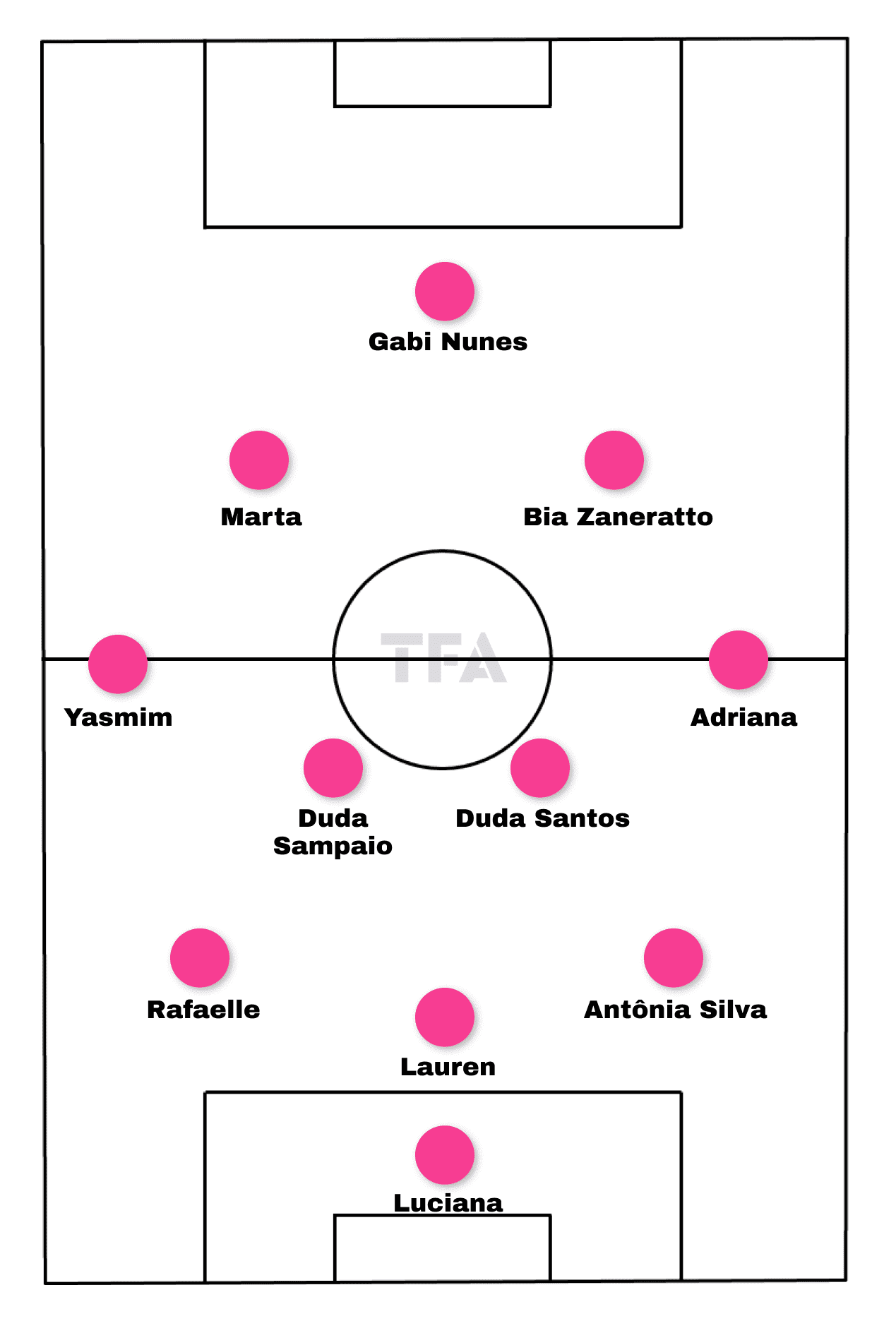
We expect Brazil to line up in a 3-4-2-1 system, which has most frequently been used since the new manager’s appointment late last year.
37-year-old Luciana is expected to start in goal following a strong showing in the Gold Cup earlier in the year.
In league competition for Ferroviária, after 12 games, she has only conceded five goals, showing the strong form has maintained all year.
Antonia Silva will start at the right side of the back three, with her having started the role in fourteen of the coach’s fifteen games in charge, earning his trust immediately.
In the heart of defence, at the centre of the back three, 21-year-old Lauren will likely play.
Although she has hardly featured for the club this season, she has often represented Brazil’s senior squad after winning the South America under 20 Championship in 2022 and earning third place at the u20 World Cup.
At left centre-back, Rafaelle has regularly featured in the role.
After swapping Arsenal in the FA Women’s Super League for Orlando Pride, she is currently part of the defence which has only conceded eleven goals in thirteen league games.
We expect Adriana, Rafaelle’s teammate, to hold the width on the right flank, playing as the wing-back, although she is an attacking-minded player.
Duda Sampaio of Corinthians is helping her club dominate the league with twelve wins in the thirteen opening games of the season from the centre of the pitch.
Although she is a more attack-minded option, her partner, Duda Santos, will attempt to provide some balance.
At left wing-back, Yasmim, a natural left-back, will play.
Bia Zaneratto is expected to start on the right-hand side in the front three.
The front three will remain fairly narrow, so even though she has often started as the centre forward for her club and managed 9 goal contributions in 8 league starts, the role will be fairly similar for Brazil.
On the left side, 38-year-old Brazil legend Marta is expected to play, although she missed the Gold Cup earlier in the year.
Gabi Nunes will lead the line at centre forward after eleven goals in twenty-three starts for Levante in the Spanish Primera Division.
There are several experienced heads in the Brazil squad.
Seven of the players are 30 years old or older, which would have given them numerous attempts at both the World Cup and the Olympics in the past.
A further six of the starting eleven for Brazil are in their prime years of their career, between twenty-seven and thirty years old.
This mix of experience, peak performers, and several young stars joining the team makes an exciting combination, shaping up a side ready to battle at the Olympics in the perfect conditions and balance of the squad.
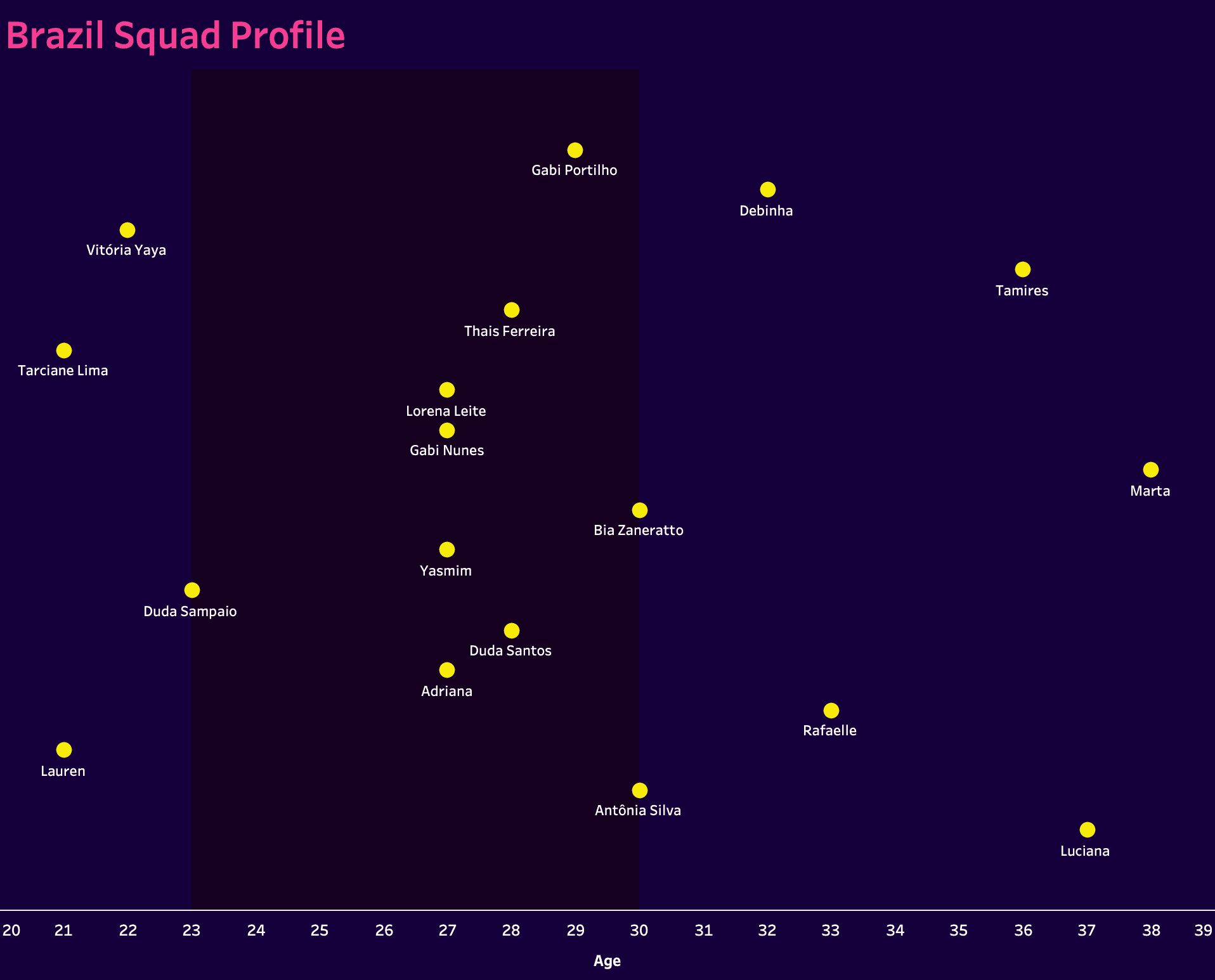
Attacking Phase
Brazil will be patient in their football during the build-up.
The back three will receive the ball often, although Brazil do not seem to have a bias to their style of playing out of the back.
When the space is in the central area, they will attempt to be incisive and play through the press, but they are also able to use other, more direct methods.
Against a narrow defence, the central defender has the ability to spray long passes to either wing-back, who receives the ball in the areas shown below.
The pressure from the opposition usually impacts the next decision, with the wing-back often controlling the ball and driving forward if she has the time and space.
When the opposite full-back jumps out of their position, the ball is played into the space they vacate, with the near-sided winger attacking that space, making the run from a central starting point.
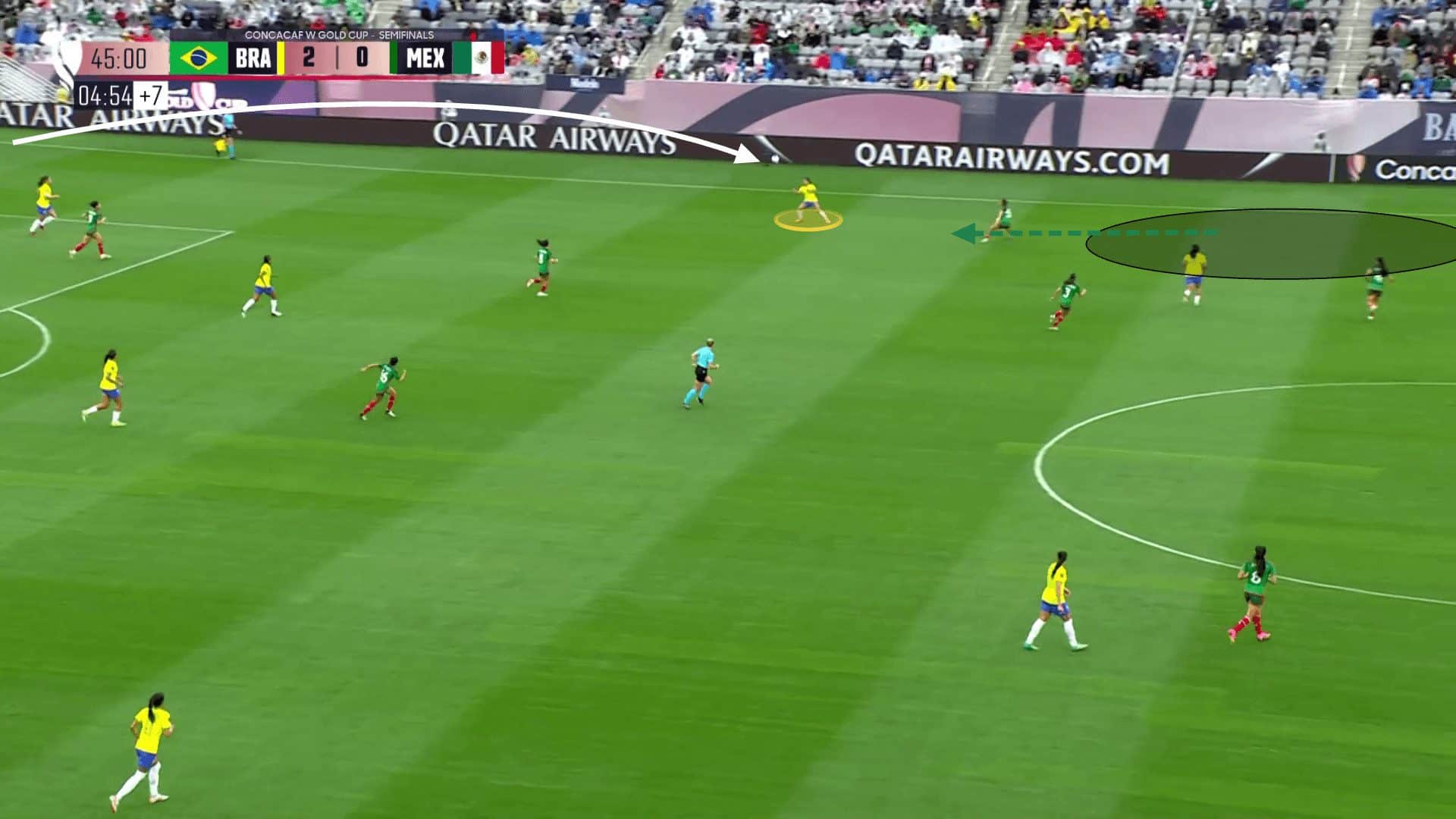
When playing through the press, we can expect Brazil to play on one side of the pitch, attracting the opposition to the side before switching play to the other side.
The wide centre-back moves wide and deep, receiving the ball by the corner flag to maximise the depth and width available to the team.
The double-pivot also moves towards the ball, while the opposite wing-back remains wide to offer an outlet out wide.
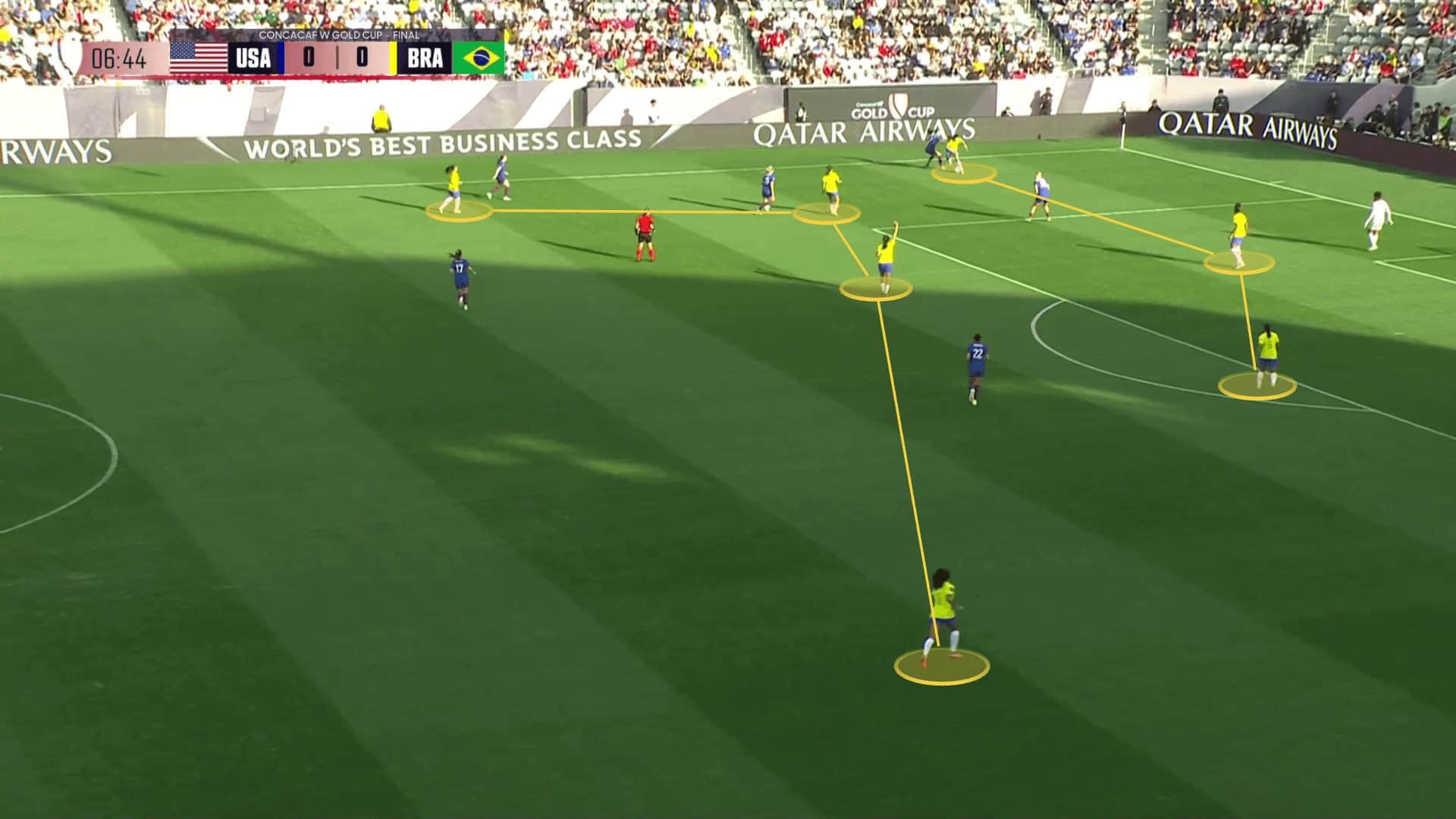
The near-sided wing-back and double-pivot are all options for the defenders to play forward.
One of the three is used as a bounce pass, laying the ball off to the other forward-facing player.
The first-time passes are made quick enough to evade the pressure.
When the forward-facing player receives the ball, he switches play to the opposite side, where the wide player can receive the ball unmarked, and the wing-back can make an overlapping run in the wide channel.
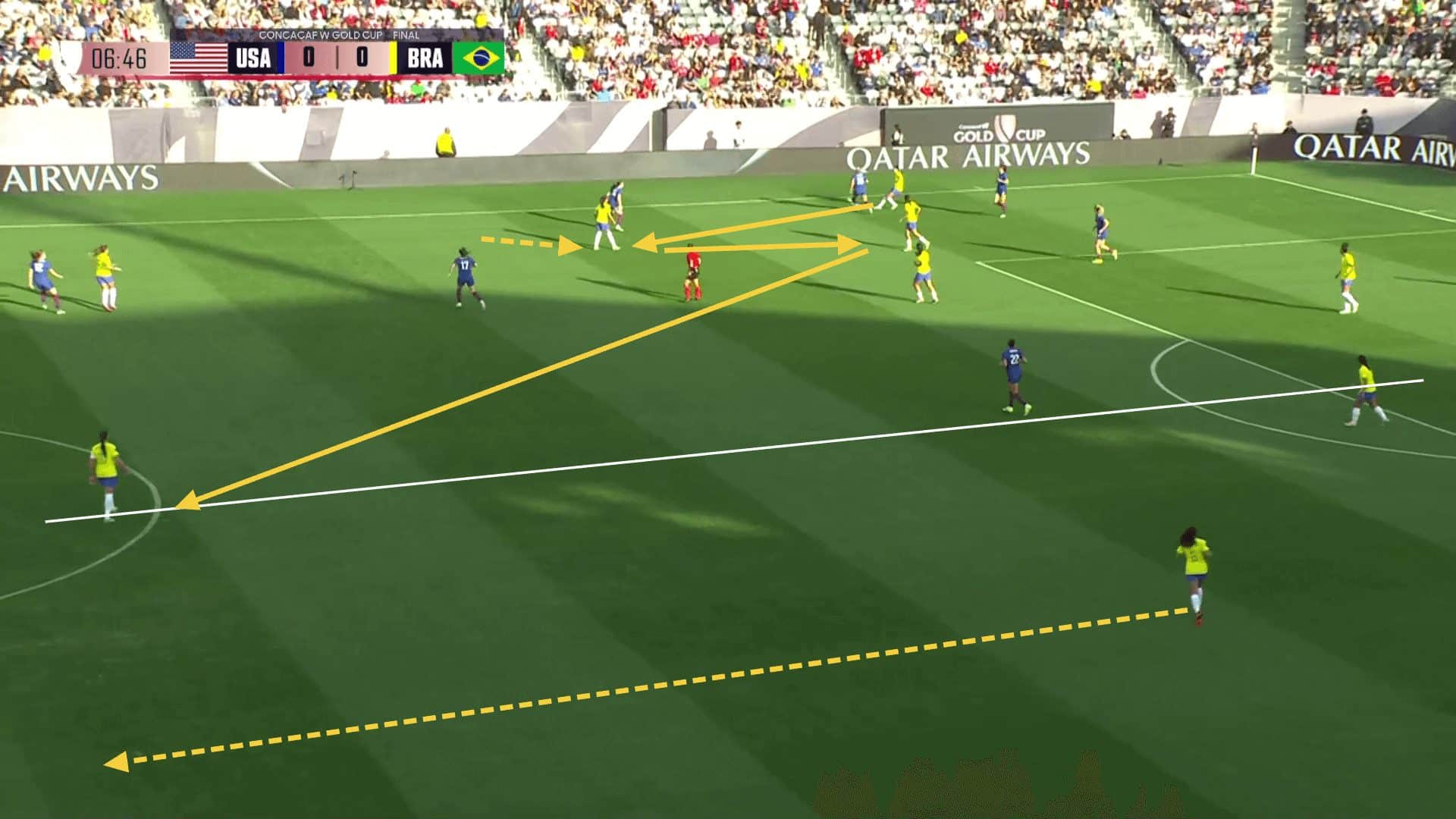
Brazil are also able to play over the initial pressure by feeding the ball into the front three.
We can see in the image below that the front three are used to pin the defensive line back, which makes the space in front of the defensive line easier to access.
Through a direct pass to the front line, one of the midfielders situated deeper can make a third-man run and arrive in the space in front of the defensive line, where she can receive the ball after a flick down and run at the back line.

In the final third, we can expect underlapping runs commonly used.
The wing-backs will hold the width for their sides, while the narrow attacking three will move in the central spaces.
When the wing-back has the ball, they will usually force the full-back to jump out of their position, creating space on the flanks.
In this case below, the right-sided attacker in the front three will attack that space by making the underlapping run, from where they can either cross the ball into the box or dribble at the next defender.
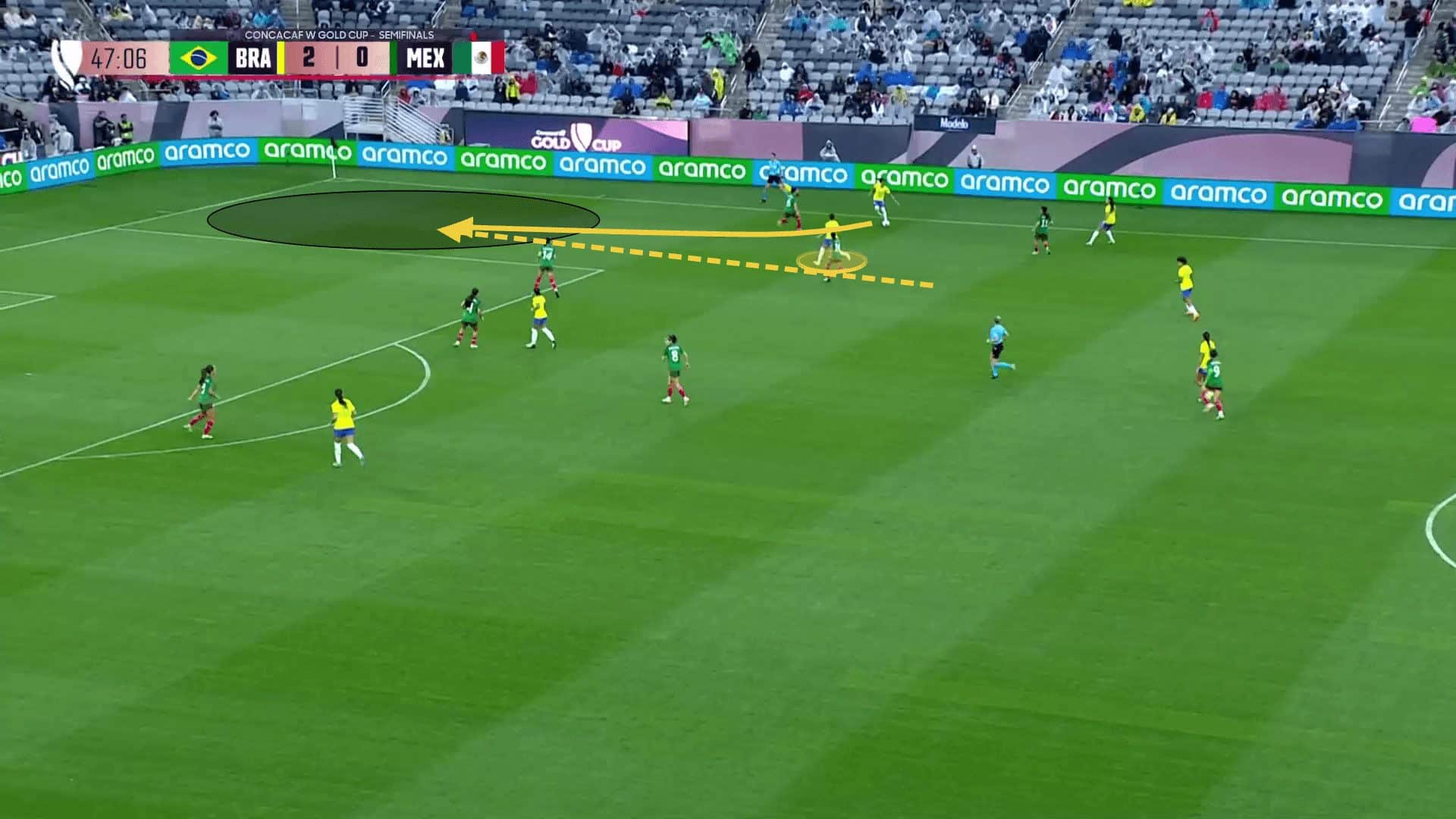
With the ball in those wide areas, Brazil aim to deliver the ball into the box quickly before the opposition can bring players back into their own box.
The other three players in the front line, labelled in the image below, are all in high positions early on, meaning they can attack the box quickly enough to meet early crosses.
The movement amongst the players is good, with runs made at different parts of the six-yard box and the players arriving in space with good timing to make life as difficult as possible for the opposition defence.
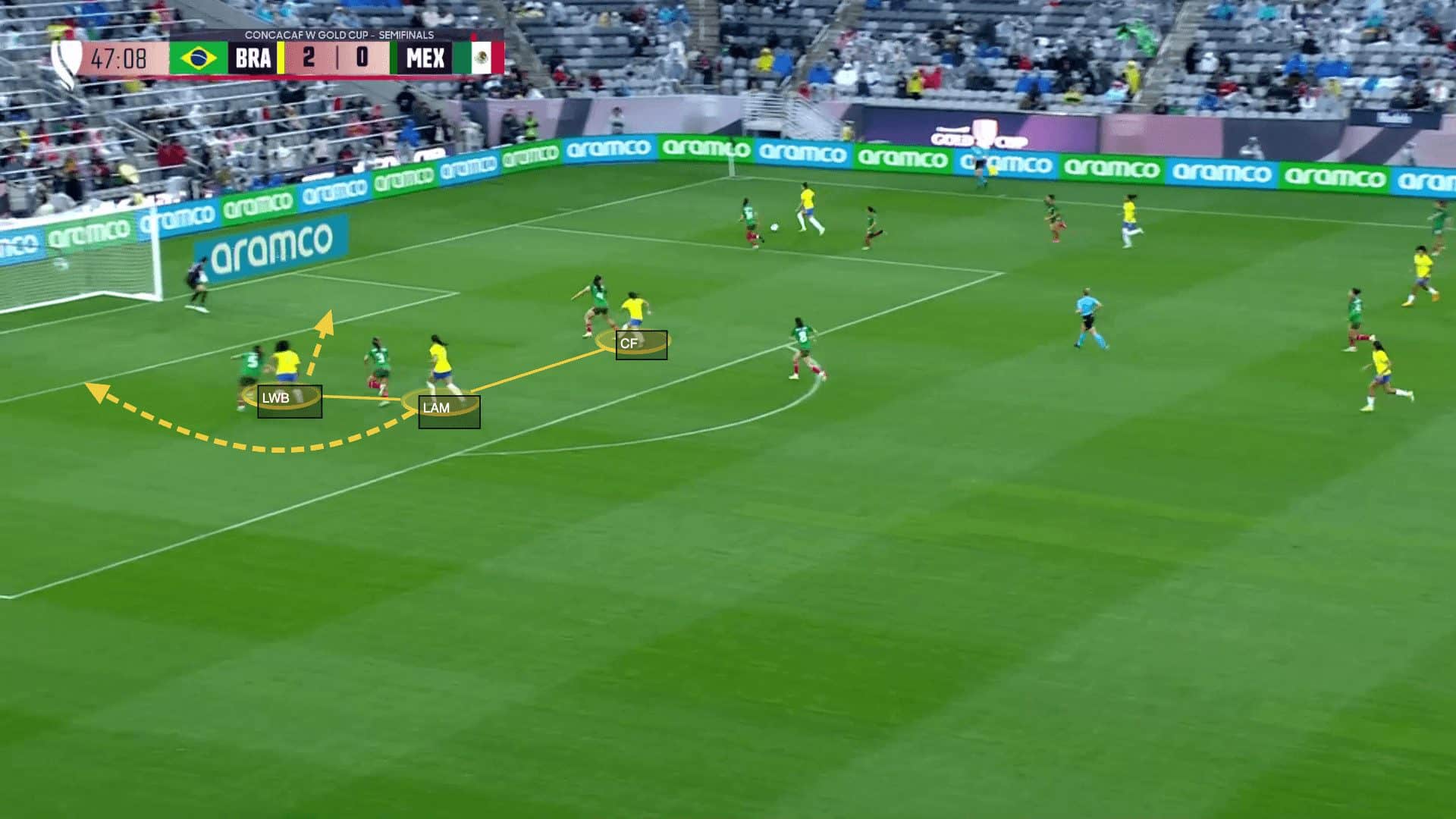
Defensive Phase
The out-of-possession setup is expected to be aggressive.
Brazil will press opponents high up the pitch when the opposition build out from the back.
The same approach will be used during open play, where, upon a backward pass, the Brazil squad goes woman for woman to force the opponents to go long.
The player pressing the goalkeeper arcs their run to cut off the short pass while putting pressure on the ball.
This approach forces many long balls as the wing-backs push up and press the full-backs while the midfielders step up to mark the opposition midfielders.
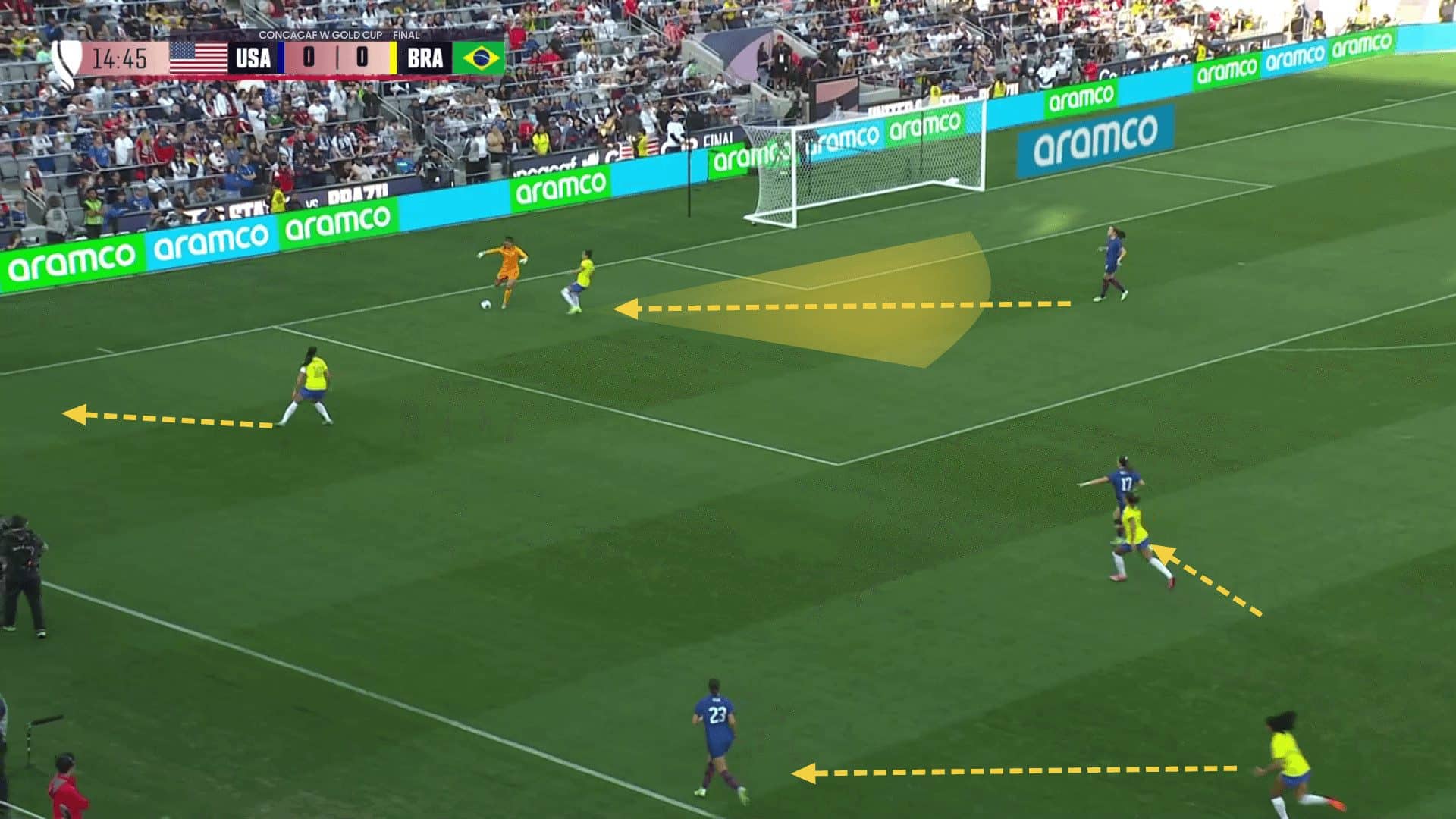
One issue with the aggressive approach is that the defensive back three is left with three individual 1v1 battles against the attacking line.
When this happens, Brazil are vulnerable to long balls, and the defenders have trouble deciding between tight marking or dropping off to protect space.
In the example below, the central defender wants to avoid the long ball being played in behind, giving the attacker enough space to receive the ball and turn and drive at the defence.
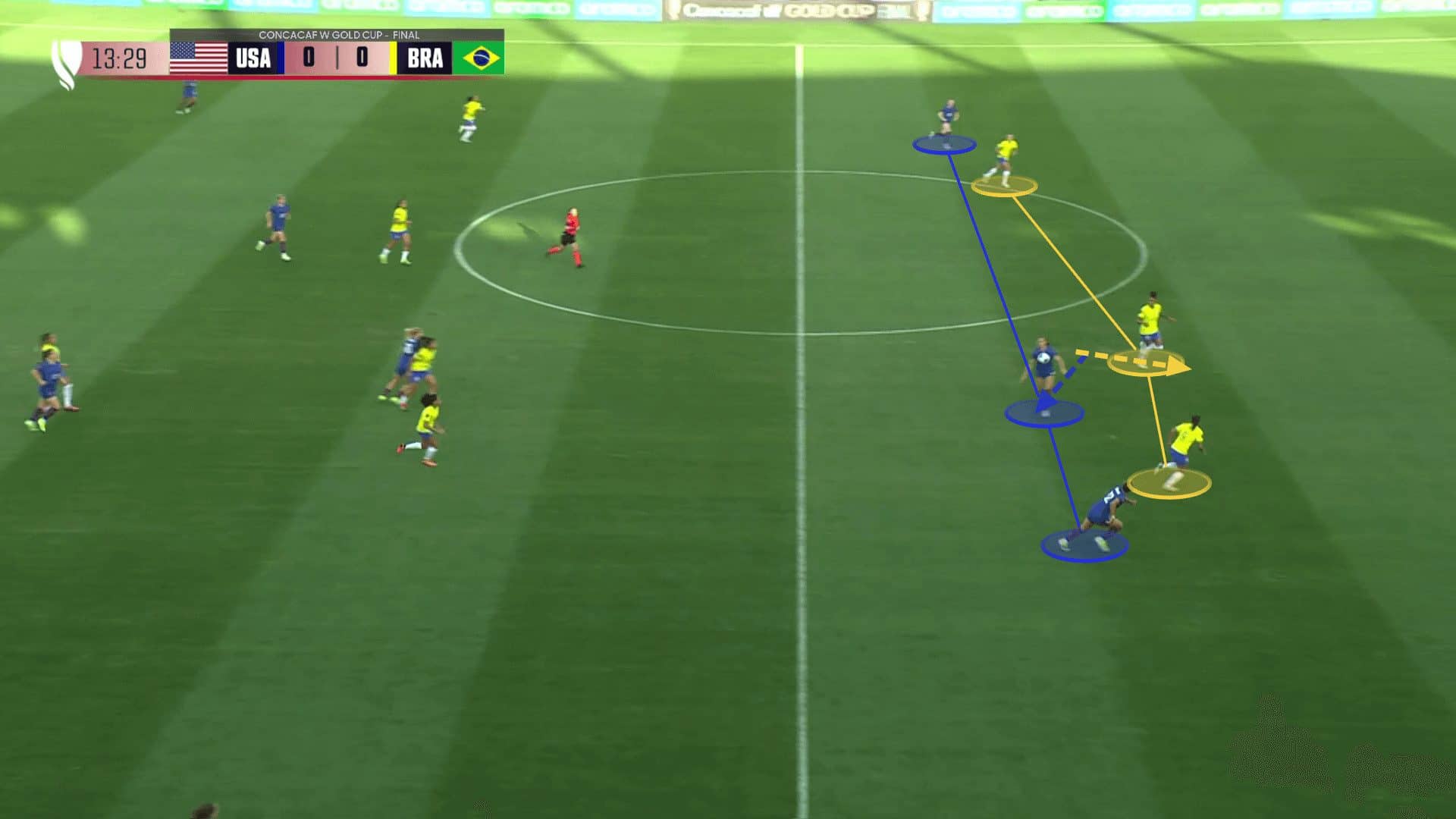
Brazil will maintain a high line, which effectively minimises the space opponents have to play in between the lines, forcing opponents to play over the press.
This plays into Luciana’s strengths, who is strong at judging the game and frequently roams outside the penalty area to sweep up balls played into the space behind.
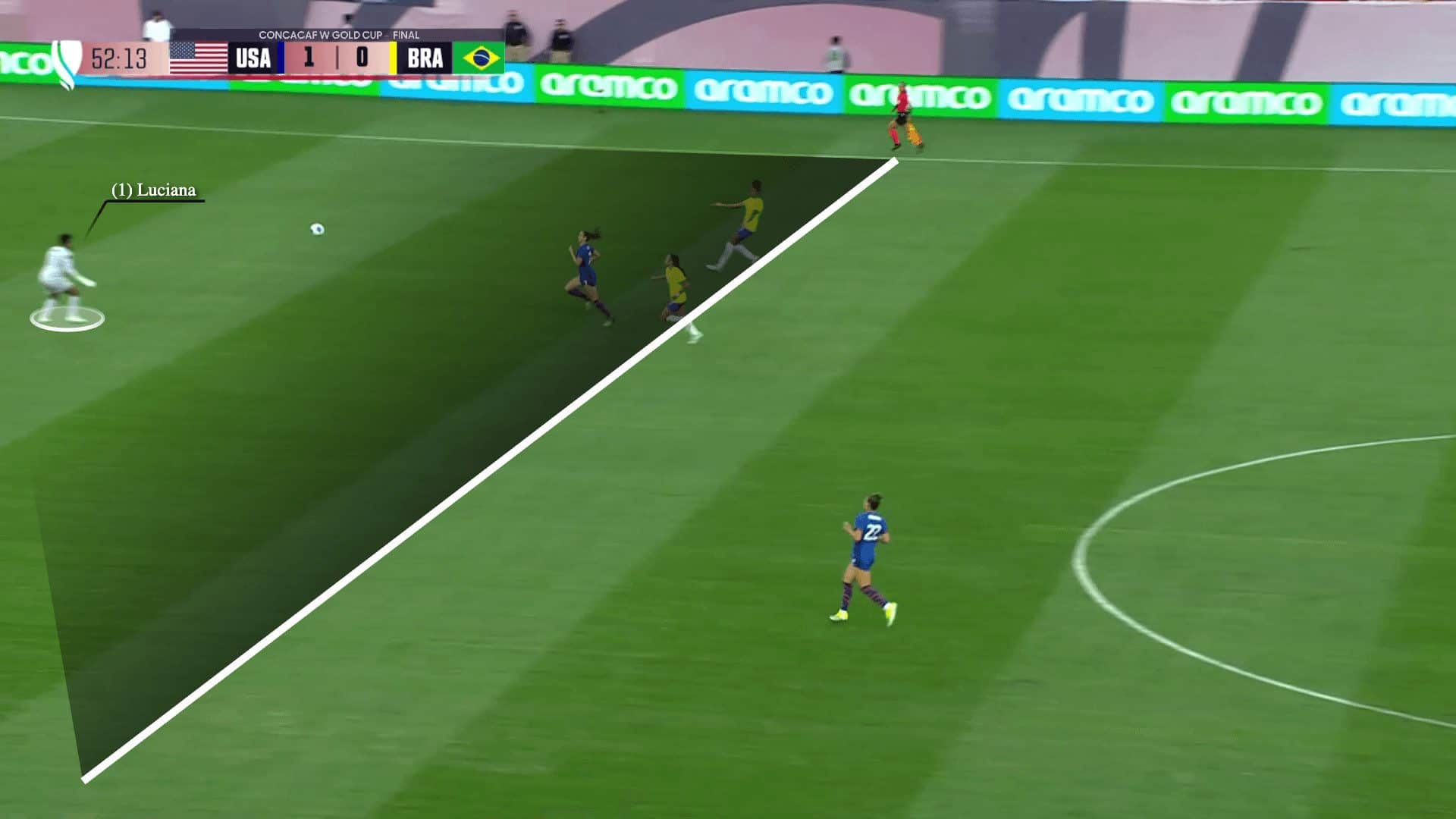
Transitions
Having the front three narrow in settled defence gives Brazil a regular counterattacking threat.
The attacking unit is close to and in numbers, which allows them to make short combinations to evade the opponent’s counterpress.
None of the attackers are isolated, so Brazil is more likely to either retain possession or counterattack after recovering the ball.
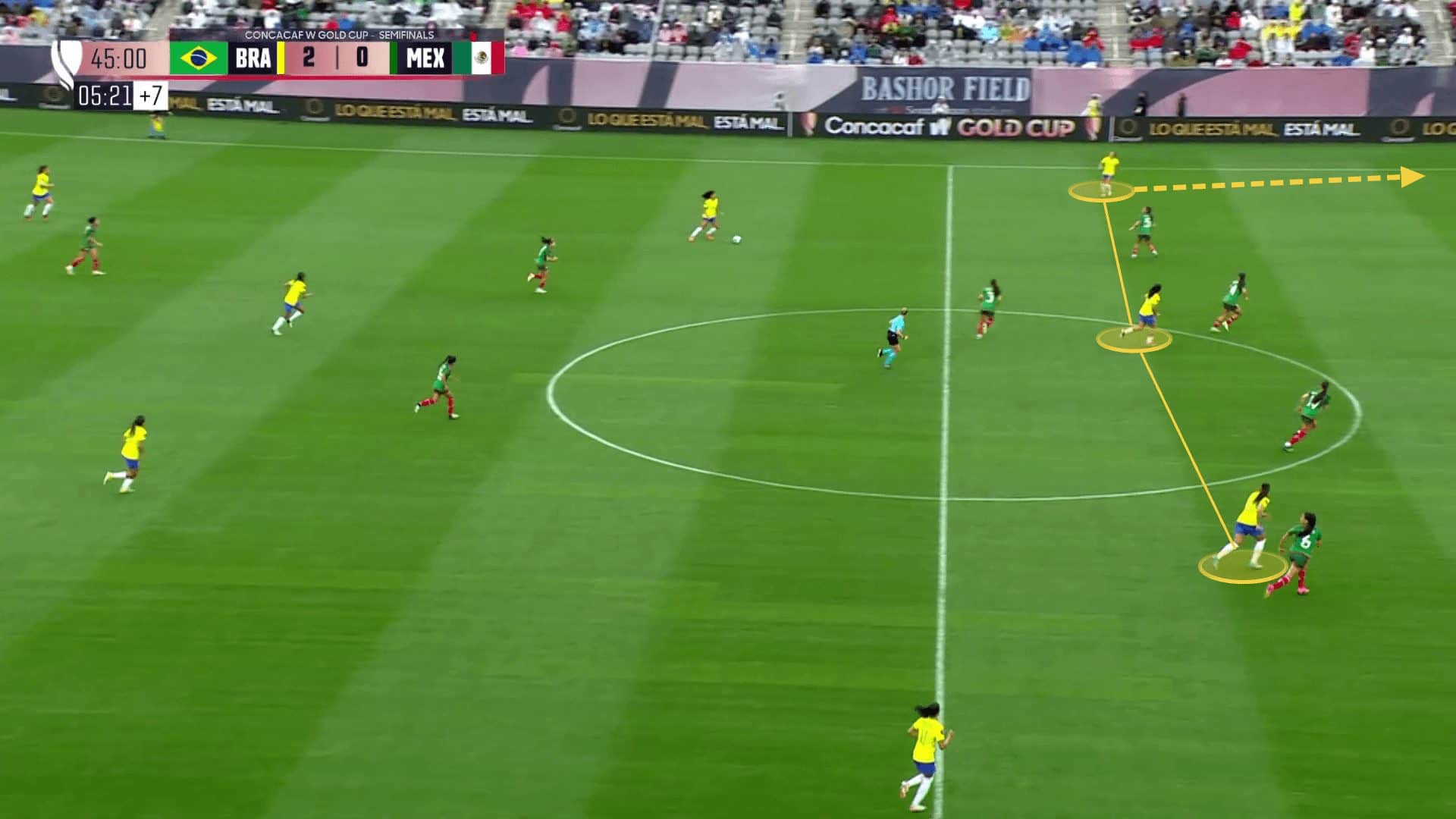
The two wide attackers are comfortable in central spaces and wider areas.
They operate in central spaces during settled play but are also comfortable moving into wider areas during counterattacks where the space is outside the block.
During the transition back to defence, Brazil’s 3-2 rest defence gives them a solid structure at the back.
The shape gives them cover along the last line to protect against the balls in behind across the width of the pitch.
The double-pivot in front can counterpress the ball after a loss of possession.
One issue that Brazil could face is the lack of aggression in the outside centre-backs during the counterpress.
They are hesitant to step up from their positions to intercept passes into the front line, which allows opponents to play the ball into the front line and lets the attack run at the defensive line.
The lack of aggression is a worry to their counterpressing and overall ability to sustain pressure on the opposition, which could lead to open games.
Forwards
Debinha has played a crucial role in Kansas City’s dominant start to the NWSL and a current unbeaten run.
For club, her versatility and unselfishness have allowed her to cover multiple players in multiple positions, and those same traits will be necessary during the Olympics to cover anywhere across the front three or inside the double-pivot.
Gabi Portilho will provide a burst of energy from the bench, coming on from the right wing as she has done at Corinthians in Brazil.
The pair are both attacking options who are comfortable in the half spaces on either side of the striker and have both had numerous starts in recent games for Brazil, so it wouldn’t be a surprise to see them earn starts in some games.
Midfielders
Vitoria Yaya will offer depth in central midfield.
She has played a vital role in Corinthians’ current dominance of the league campaign.
She is a potential creative spark that Brazil can turn to when it needs it, with a willingness to consistently play balls into space beyond the defensive line.
Yaya has the patience to delay the pass until the right moment and can evade pressure and hold off opponents to wait until the right moment comes.
She has the range in her passing to play balls over the top or on the floor, with a range of distances at her disposal.
Her teammate Tamires will be an option in the wingback department, and her experience will be vital in seeing off games.
She is a full-back for her club but has also played higher up the pitch in wide areas, making her a perfect candidate for a wing-back role for her nation.
Defenders
Thais Ferreira and Tarciane Lima will be defensive options along the back three.
They have plenty of experience in the recent Gold Cup, so it would be no surprise to see them starting during the Olympics.
The pairing started in the Gold Cup final against the USA, so they have the coach’s trust, but with all options available, their minutes will likely be earned off the bench.
Thais Ferreira’s versatility portrays a theme along the coach’s expected squad picks.
Ferreira has played as a holding midfielder for Granadilla but will be used in a central defensive role for Brazil.
Lima, a natural central defender for the club, will be used as cover for Brazil, although her lesser experience means that the high-pressure environment will be left to the older squad members.
Key Player
Marta’s experience and quality will be essential to Brazil’s success at the Olympics.
Although Marta is supposed to retire after the Olympics, the upcoming World Cup in Brazil could potentially change her mind.
The six-time World Player of the Year is excellent in the attacking midfield position.
She is comfortable in tight spaces and can craft out chances under pressure, whether that is up against a deep compact defence or against a high line, which Marta can exploit by dribbling up the pitch with speed.
While she can create chances through excellent dribbling and passing in short spaces, she can also affect the game over larger spaces in transitions whilst being deadly in front of goal to finish off those attacks as well.
A complete player in the front line who will ensure the team succeeds by adapting her role, whether that means becoming more creative or more attacking from game to game.
Tournament Prediction
Based on the analysis above, Brazil will likely qualify out of their group.
However, based on the individual quality of some opponents like Spain and the US, a quarter-final or potential semi-final exit is on the cards.

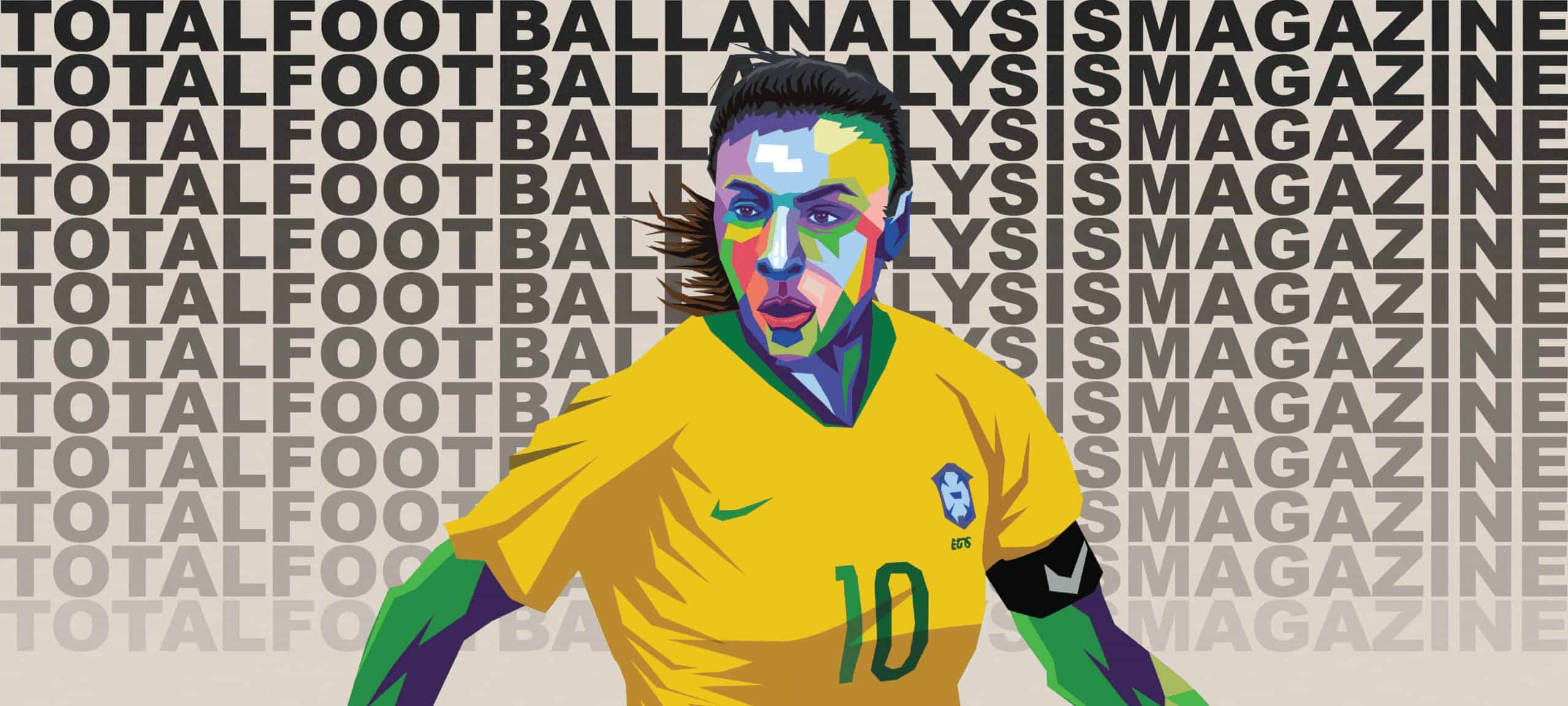




Comments